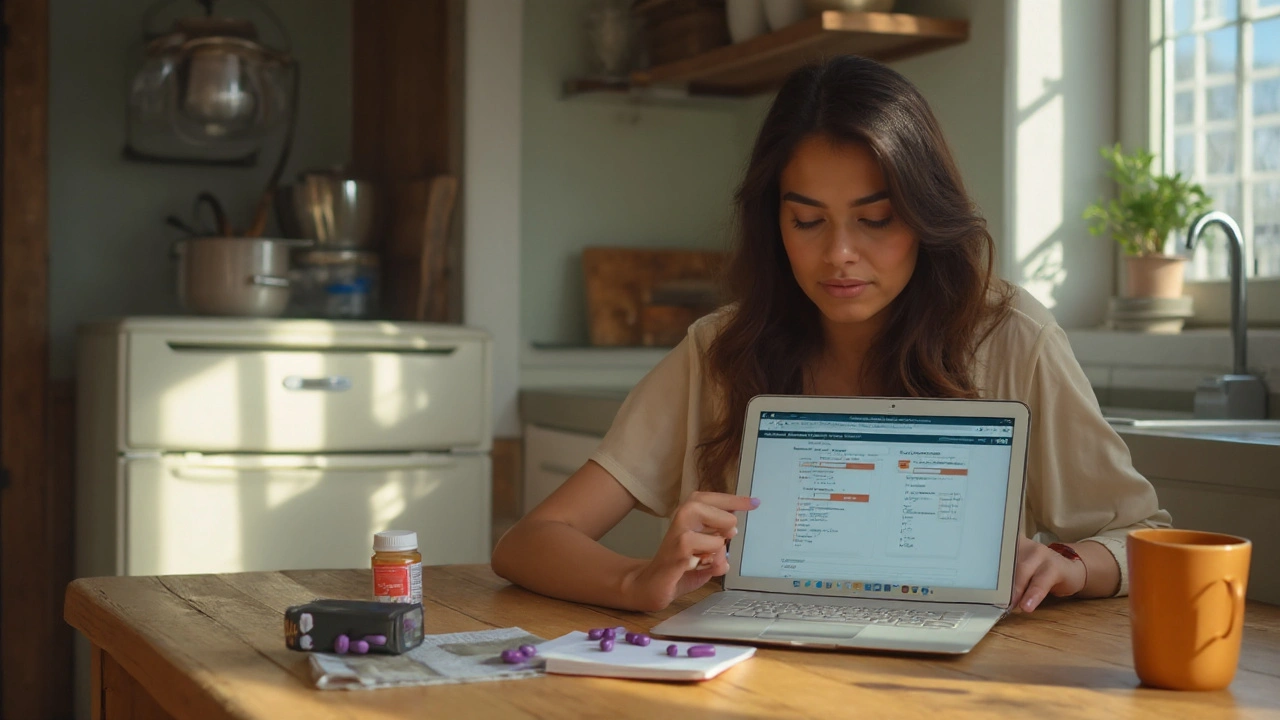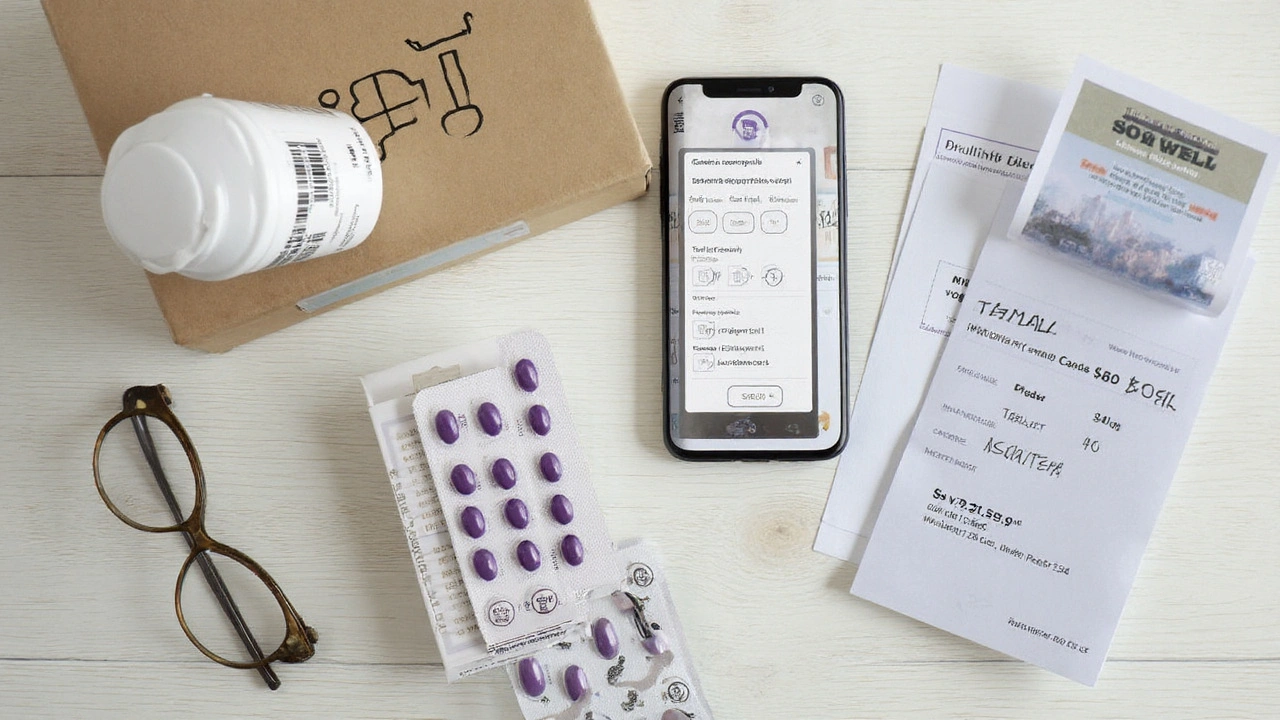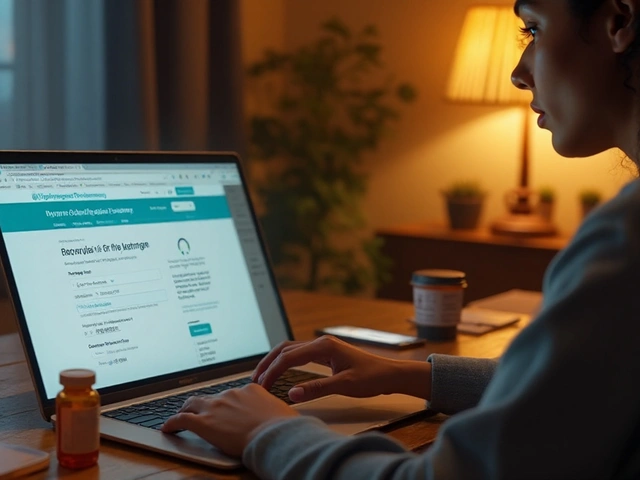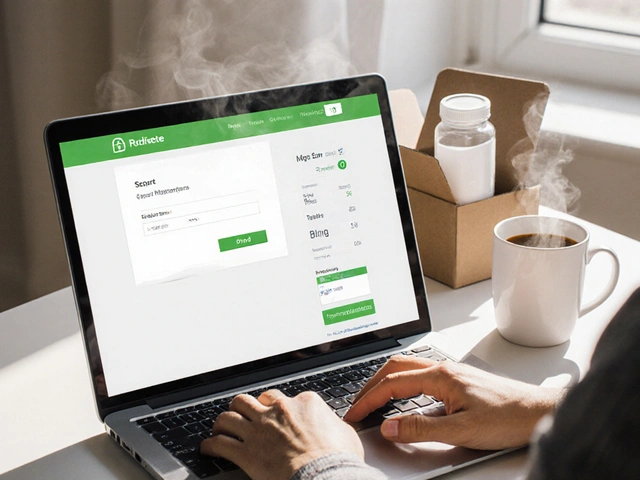
Most “cheap Nexium” ads either upcharge you on shipping or sell stuff you shouldn’t trust. If you want a fair price on esomeprazole without risking fakes or paying brand-name markups, you’re in the right place. Here’s what’s realistic today: safe places to buy, what a good price looks like in 2025, how to pick the right dose and form, and how to avoid the traps that waste time and money.
Before we jump in, here are the real jobs you probably want to get done after landing here:
- Find a legit online pharmacy that won’t sell you counterfeits.
- Pay a low, fair price for the exact strength you need (OTC 20 mg or Rx 40 mg).
- Know when you actually need a prescription versus when OTC is fine.
- Compare esomeprazole to cheaper alternatives like omeprazole or pantoprazole.
- Order today with clear steps and avoid common mistakes.
What to buy and how to buy it safely online today
Esomeprazole is the active ingredient in Nexium. It’s a proton pump inhibitor (PPI) that lowers stomach acid. You’ll see it sold two ways in the U.S.:
- OTC (no prescription): 20 mg delayed-release (often labeled “Nexium 24HR” or store-brand “esomeprazole magnesium”). Used for frequent heartburn in 14-day courses.
- Prescription (Rx): typically 40 mg delayed-release capsules, plus 10 mg granules for oral suspension in some cases. Used for diagnosed conditions like erosive esophagitis, and sometimes as part of H. pylori treatment when a PPI is indicated per your clinician.
What it does well: reduces heartburn and heals acid-related irritation over days, not minutes. What it doesn’t do: give instant relief (that’s what antacids or an H2 blocker like famotidine can do while you wait for the PPI to kick in).
If your goal is to generic Nexium online without drama, here’s the safest route.
Step 1: Decide the right strength for your situation
- Frequent heartburn (2+ days/week) without alarm symptoms (trouble swallowing, bleeding, weight loss, black stools): OTC esomeprazole 20 mg once daily, 30-60 minutes before breakfast, for 14 days. If symptoms return, you can repeat after 4 months or see your clinician sooner if symptoms persist.
- Diagnosed GERD with erosive esophagitis or your clinician told you to take 40 mg: you need a prescription in the U.S. for 40 mg. Don’t buy “no-prescription” 40 mg from random sites.
Step 2: Pick a verified pharmacy
Safe options in 2025:
- Major U.S. retailers with online pharmacies (think the big box stores and supermarket chains). They’re typically verified by the National Association of Boards of Pharmacy (NABP).
- U.S.-licensed mail-order pharmacies connected to your insurance plan. These ship 90-day fills with predictable pricing.
- Sites and apps that are listed by NABP’s .pharmacy program or validated by LegitScript. If a site hides its address, sells prescription-only drugs without a prescription, or only takes crypto/wire, skip it.
Trust badges to look for: NABP .pharmacy, LegitScript certification, or listings through FDA’s BeSafeRx. You don’t need to chase every icon, but you should be able to confirm the site is licensed in the U.S. and requires a valid prescription for Rx strengths.
Step 3: Compare total cost (not just the pill price)
- Add up unit price + shipping + taxes + any membership fees.
- Look at cost per dose. Example: $22 for 42 OTC tablets is about $0.52 per dose. If a site advertises $0.40 per pill but charges $12 shipping, your per-dose cost may be higher unless you buy in bulk.
- Time is money: standard U.S. shipping is 2-5 days. International mail-order can be 2-3 weeks. If you need it now, factor speed into “cheap.”
Step 4: Place the order
- OTC 20 mg: add a 28- or 42-count box to your cart. If you tolerate it and plan repeat courses, a subscribe-and-save plan can shave a few cents per dose.
- Rx 40 mg: upload your prescription or ask if the pharmacy offers a telehealth visit. Many do quick PPI refills if appropriate. Avoid any site that sells 40 mg without a prescription-big red flag.
Step 5: Check the package when it arrives
- Look for a known generic manufacturer (Teva, Dr. Reddy’s, Sandoz, Viatris/Mylan, etc.), a lot number, and a clear expiration date.
- Seals should be intact. Capsules should match the imprint described on the bottle or insert. If something looks off, contact the pharmacy before taking it.
Step 6: Use it right for real results
- Take it at the same time daily, about 30-60 minutes before your first meal.
- Don’t chase spicy pizza with a PPI and expect instant relief. If you need fast relief while waiting for the PPI to work (usually 1-3 days), keep an antacid or famotidine handy.
- OTC course is 14 days. If you still need it every day after that, talk to a clinician.
Quick story from my house: Nina had on-and-off reflux last winter. We price-checked brand-name boxes against store-brand esomeprazole online and in-store. The online pharmacy attached to a warehouse club had the best deal: $21.99 for 42 tablets with free 2-day shipping. That beat two marketplace sellers advertising $0.39 per pill but tacking on $8-$12 shipping. The club’s site also listed the manufacturer and expiration clearly-small thing, big peace of mind.
Pro tips
- Unit price under $0.50 per 20 mg OTC dose with free or low-cost shipping is a solid 2025 price. Under $0.40 is a great price from a verified seller.
- If you take a PPI often, consider a 90-day Rx esomeprazole 20 mg or 40 mg (if prescribed). Mail-order often drops the cost to the teens per month with discounts or insurance.
- Rebound can happen when you stop a PPI suddenly. If you’ve been on it a while, taper to every other day for a week, and bridge with famotidine or antacids.

Prices, options, and comparisons that actually save money
Realistic U.S. pricing snapshots for 2025 (cash prices; your plan may beat these):
- OTC esomeprazole 20 mg delayed-release: 14-count boxes often run $9-$14; 28-count $15-$22; 42-count $19-$32. Store brands usually land on the low end. Good unit-price target: $0.35-$0.60 per dose when shipping is free.
- Rx esomeprazole 40 mg capsules (generic): with popular pharmacy coupons, 30 capsules often price at $8-$20 at big chains. Without a coupon, sticker prices can hit $60-$200. A 90-day supply with mail-order commonly runs $15-$40 cash with a discount card.
- International mail-order (legit, requires Rx for 40 mg): bulk pricing can be $0.20-$0.50 per 20 mg capsule and $0.30-$0.70 per 40 mg, plus $10-$15 shipping and 2-3 week delivery. Only worth it if you’re stocking up and the pharmacy is properly licensed in its country and recognized by an independent verifier.
How to compare apples to apples
- Compute cost per dose. Example: $24.99 for 42 tablets = $0.60 per dose. $18.49 + $7.99 shipping for 42 tablets = $26.48, or $0.63 per dose.
- Check if you’re getting magnesium delayed-release capsules (the common U.S. OTC form). Some international products use different salts or labeling; that’s okay if licensed, but match the strength and form your clinician recommended.
- Prefer 42-count (or bigger) boxes for OTC if you can store them. Even if you don’t take them daily, they don’t go bad quickly if sealed and kept dry.
Brand vs generic
Generics must match the brand’s active ingredient, dose, and absorption within tight FDA limits. People sometimes feel differences between manufacturers, but when you buy from a licensed pharmacy, bioequivalence standards apply. If a switch bothers you, ask the pharmacy to stick to one manufacturer when possible.
Esomeprazole vs cheaper alternatives
- Omeprazole 20 mg (OTC or Rx): Often the cheapest PPI. Cash prices can drop to $0.05-$0.20 per dose for store brands in bulk.
- Pantoprazole 40 mg (Rx): Very affordable with coupons, often $4-$15/month for 30 tablets. Tends to have fewer interactions than esomeprazole with some drugs (like clopidogrel).
- Lansoprazole 15 mg (OTC) or 30 mg (Rx): Similar efficacy and pricing to esomeprazole in many settings.
- Famotidine (H2 blocker): Not a PPI. Good for on-demand relief or to taper off PPIs. Often costs pennies per dose.
Which is “best”? Head-to-head data show PPIs are broadly similar for common reflux. Some trials suggest slightly higher healing rates with esomeprazole in erosive disease, but for day-to-day heartburn, omeprazole or pantoprazole often work just as well for less money. The American College of Gastroenterology’s GERD guideline points to using the lowest effective dose and stepping down when possible.
Decision guide
- If your heartburn shows up more than 2 days a week: try an OTC 14-day PPI course (esomeprazole or omeprazole). If it works, stop after 14 days and use lifestyle tweaks; repeat only if symptoms come back later.
- If you need daily therapy beyond 14 days, or have alarm signs (trouble swallowing, bleeding, unexplained weight loss, chest pain), talk to a clinician before continuing.
- If you’re on clopidogrel: avoid esomeprazole and omeprazole unless your cardiology team says okay; pantoprazole is often preferred.
- If cost is king and symptoms are mild: start with omeprazole. If that fails, step to esomeprazole or pantoprazole.
Dosing and how to take
- Esomeprazole 20 mg OTC: once daily 30-60 minutes before breakfast for 14 days.
- Esomeprazole 40 mg Rx: dose and duration per your clinician (common: once daily for 4-8 weeks in erosive disease).
- Capsules can often be opened and sprinkled on a spoon of applesauce if you can’t swallow pills. Don’t crush the granules. Check your product insert to confirm.
Interactions to know
- Clopidogrel (Plavix): esomeprazole can reduce its activation. Ask about pantoprazole instead.
- High-dose methotrexate: PPIs can increase levels-tell your team.
- Drugs needing stomach acid for absorption (e.g., some antifungals): PPIs may reduce absorption.
Lifestyle wins that save money
- Raise the head of your bed 6-8 inches if nighttime reflux hits.
- Avoid large late meals; limit alcohol late at night; watch trigger foods (tomato, citrus, chocolate, mint, spicy, fatty).
- Weight loss, even 5-10%, can improve reflux and reduce how much medication you need.

Risks, quality checks, and what to do next
Online pitfalls and how to avoid them
- Counterfeits: The World Health Organization has reported significant rates of substandard or falsified medicines in some markets. Stick with licensed pharmacies listed by NABP or validated by LegitScript to reduce your risk.
- Too-good-to-be-true deals: If a site offers prescription-only strengths without a prescription, hides contact details, or demands crypto-only payments, walk away.
- Heat and humidity: PPIs are stable at room temp, but don’t leave your package on a hot porch all day. Store in a dry spot under 86°F (30°C).
Side effects and safety
- Common: headache, diarrhea, constipation, gas, abdominal pain.
- Less common but important with longer-term or high-dose use: low magnesium, vitamin B12 deficiency, bone fracture risk, C. difficile diarrhea, and kidney issues. Large reviews link these risks mainly to prolonged use; short OTC courses are generally low risk.
- If you develop severe diarrhea, persistent stomach pain, new rash, or signs of an allergic reaction, stop and seek care.
Special situations
- Pregnancy: Data haven’t shown a major increase in birth defects with PPIs, but decisions are individual. Talk with your OB before starting or continuing a PPI.
- Breastfeeding: Small amounts may pass into milk. Discuss risks and benefits with your clinician.
- Older adults: Consider bone health; use the lowest effective dose. Ask about calcium and vitamin D if you’re on long-term therapy.
Mini-FAQ
- Do I need a prescription? Not for 20 mg OTC. Yes for 40 mg in the U.S.
- How fast does it work? Some feel better in 24 hours; full effect can take 2-3 days.
- Can I take it with antacids or famotidine? Yes. Use those for quick relief while waiting for the PPI to work.
- Can I drink coffee or alcohol? You can, but both can worsen reflux. If symptoms flare, cut back.
- Is it safe to buy on big marketplaces? Buy from the retailer itself or its licensed pharmacy arm, not random third-party sellers.
- What about breaking the capsule? Many esomeprazole capsules can be opened and sprinkled on a spoon of applesauce; don’t crush granules. Check your insert.
Before-you-buy checklist
- Which strength do I need today (20 mg OTC vs 40 mg Rx)?
- Is the pharmacy licensed and listed by NABP or validated by LegitScript?
- What’s my cost per dose including shipping?
- How fast do I need it (2-5 days vs 2-3 weeks)?
- Any drug interactions (clopidogrel, high-dose methotrexate)?
Ordering today: simple path
- Choose a verified U.S. pharmacy site or your insurer’s mail-order.
- For OTC 20 mg: buy a 42-count box if it’s the best unit price. For Rx 40 mg: upload your prescription or book a quick telehealth review.
- Pick free shipping if arrival fits your timeline. Otherwise, pay for 2-day shipping (usually still cheaper than driving around).
- When the package arrives, check the seal, lot number, and expiration. Keep the insert.
- Start 30-60 minutes before breakfast. Set a daily reminder.
If something goes wrong
- The package looks sketchy: don’t take it. Contact the pharmacy; ask for a replacement or refund.
- No improvement after 14 days of OTC: contact your clinician. You may need an evaluation or a different plan.
- Symptom red flags: chest pain, vomiting blood, black stools, or trouble swallowing-seek care immediately.
Clear, ethical next step
If you’re buying OTC 20 mg for frequent heartburn, grab a verified store-brand esomeprazole 42-count online at a unit price under $0.50 with free shipping. If you need 40 mg, use a licensed pharmacy that requires a real prescription or offers telehealth. That keeps you safe, cuts costs, and gets the job done without guesswork.
Why you can trust this guidance
The dosing and safety points line up with FDA labeling for esomeprazole products and the American College of Gastroenterology’s GERD guidance. The safety checks match FDA’s BeSafeRx advice and NABP verification standards that licensed pharmacies follow. Pricing ranges reflect typical U.S. cash pricing and discount card data as of August 2025; your exact price may be better with insurance or local promos.





Comments (11)
Maureen Crandall
If you're on a fixed budget focus on unit price not headline price
Buying a 42 count OTC box usually beats a tiny 14 pack even if the sticker looks higher
Also check shipping cost and the expiration date before you pay and keep a photo of the bottle once it arrives
Michelle Pellin
Telehealth refills are a little dramatic but they are a lifesaver for getting the legit 40 mg without sketchy sites
You can get a clinician note same day and avoid those weird offshore sellers that promise magic pricing
Use a verified pharmacy badge and save the televisit receipt in case insurance or a coupon asks for proof later
Keiber Marquez
Dont trust random overseas shops that dodge rules they sell cheap but you get who knows what inside
Stick with US licensed pharmacies or big retailers and use coupons if you want low price and safety
Lily Saeli
Choosing where to buy is also a moral act people miss that
When you insist on licensed sources you protect not only yourself but the little chain of honest workers who actually make and ship real medicine
Buying from shadow sellers is a short term thrill that can hurt others down the line
Monika Kosa
There are clever schemes where sites reroute stock or relabel legit meds so they can jack up prices later
Sometimes they mix real pills with substandard batches and you only notice after a few weeks of weird symptoms
Always save the pharmacy contact info and image the lot number it helps if you need to report something
Derek Dodge
Grab the 42 count with free shipping, set a reminder to take it before breakfast, done
AARON KEYS
Look for the imprint code on the capsule and cross check it with the manufacturer listing before taking the medication
Imprints are a quick verification step that most people skip but it takes less than a minute
Also confirm the site shows a physical address and pharmacy license number on the contact page and save that info
Summer Medina
For anyone switching PPIs keep a short log of what you take and how you feel each day it helps more than you think
Start with the lowest effective dose and dont be one of those folks who keeps ramping up before trying simple changes like timing and food tweaks
Tapering matters and rebound acid is real so if youve been on a PPI for months reduce slowly and bridge with famotidine or antacids rather than stopping cold turkey
Insurance and coupons can slash costs but you need to read the fine print because some discount cards only work at certain chains and others require a membership
When mail order sends a 90 day supply store it in a cool dry place and check the seal on arrival and the lot number against the manufacturer batch info if you can find it online
Pregnancy and breastfeeding are special cases so do not assume OTC is automatically okay for long term use in those situations check with your clinician
If you take clopidogrel mention it to the prescriber because switching to pantoprazole is often the safer choice for those on that antiplatelet agent
International pharmacies can be cheaper but they should still be verifiable by an independent body and they should require a prescription for Rx strengths otherwise walk away
People sometimes say brand feels different but generics are tested for bioequivalence and most differences are perception not pharmacology so keep that in mind when you see different manufacturers
Keep a copy of your prescription and telehealth notes where you can find them because pharmacies sometimes ask for verification when they fill a different brand or in case of recalls
Watch for interactions with drugs that need stomach acid for absorption and high dose methotrexate which can be affected by PPIs and needs monitoring
Side effects are usually mild on short courses but long term use has documented risks so use the shortest course that controls symptoms
Make lifestyle changes like raising the bed head and losing a bit of weight first before assuming you need lifelong therapy and track progress in the log I mentioned earlier
Finally keep receipts and photos of bottles for at least a few months in case you need a refund or to report a problem to the pharmacy or regulator
It is not glamorous but being methodical saves time money and health in the long run and thats worth doing even if it feels tedious
Melissa Shore
Agree with the log idea and the step down approach I do this with almost every med I take and it cuts a ton of unnecessary cost
When tapering I do a week of every other day then a bridge day with famotidine then drop again this has worked for me and a few friends
Also insurers often have preferred generics so call them first and ask which manufacturer they prefer for a lower copay then ask the pharmacy to source that maker
Gail Hooks
Love the tapering tips and the paperwork reminder very practical 😊
Also I keep a tiny notebook in the medicine drawer with dates doses and any odd effects it makes follow ups so much easier and less stressful 😊
Maureen Crandall
Noted the notebook trick will do that next refill
Also keep digital backups of those photos for extra peace of mind